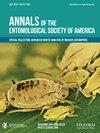Discovery of Specialist Beech-Feeding Underwing Moths From Taiwan (Lepidoptera: Erebidae: Catocalinae) and Its Implication to Biodiversity Conservation of Taiwan Beech Forests
IF 3
3区 农林科学
Q1 ENTOMOLOGY
引用次数: 1
Abstract
Abstract Deciduous Beech (Fagus spp.) forests have a highly disjunct distribution in the Northern Hemisphere, with greatest diversity in eastern Asia. Although Fagus supports a rich phytophagous insect fauna, the diversity, composition, and host specialization of insects associated with these trees in Asia are less well known compared with Europe and North America. For instance, two species of Catocala moths, both considered endemic to Japan, were previously known as the only beech-feeding specialists of this genus. However, two Catocala species were recently discovered from Taiwan during a survey of phytophagous insects on Taiwan Beech Fagus hayatae, a threatened plant. Identification of these two species of moths was determined by mtDNA (COI barcodes), adult morphology, including wing pattern and genitalia, and biology. Based on these multiple sources of evidence, we conclude that one species represents an undescribed species and the other a new subspecies of a species previously known only from mainland China. The taxonomic treatments in the present work include Catocala seiohbo sanctocula Hsu & Huang, subsp. nov., C. nimbosa Hsu & Wang, sp. nov. and C. nubila ohshimai, stat. nov. In Taiwan, Catocala spp. occur mainly in large, undisturbed patches of Taiwan Beech forest and are codependent on F. hayatae. Thus, they are not only considered to be at risk of co-extinction, but may serve as potential indicator species to monitor the extent and health of this threatened ecological community.台湾特殊食山毛榉翅下蛾的发现及其对台湾山毛榉森林生物多样性保护的启示(鳞翅目:绿蛾科:毛蛾科)
摘要落叶山毛榉(Fagus spp.)林在北半球具有高度不连续的分布,其中东亚的多样性最大。尽管Fagus支持丰富的植食性昆虫区系,但与欧洲和北美相比,亚洲与这些树木相关的昆虫的多样性、组成和寄主专业化还不太为人所知。例如,两种Catocala蛾都被认为是日本的特有种,以前被认为是该属唯一的山毛榉觅食专家。然而,台湾最近在对台湾山毛蜂(一种受威胁的植物)进行植食昆虫调查时发现了两种Catocala。通过线粒体DNA(COI条形码)、成虫形态(包括翅膀图案和生殖器)和生物学来确定这两种蛾的鉴定。基于这些多个证据来源,我们得出结论,一个物种代表一个未描述的物种,另一个是以前只在中国大陆已知的物种的新亚种。本工作中的分类处理包括Catocala seiohbo-sanchocula Hsu和Huang,亚种。在台湾,Catocala spp.主要分布在台湾大面积未受干扰的山毛蜂林中,并相互依赖于F.hayatae。因此,它们不仅被认为有共同灭绝的风险,而且可能成为监测这一受威胁生态群落的范围和健康状况的潜在指标物种。
本文章由计算机程序翻译,如有差异,请以英文原文为准。
求助全文
约1分钟内获得全文
求助全文
来源期刊
CiteScore
4.90
自引率
0.00%
发文量
25
审稿时长
6-12 weeks
期刊介绍:
The Annals of the Entomological Society of America exists to stimulate interdisciplinary dialogue across the entomological disciplines and to advance cooperative interaction among diverse groups of entomologists. It seeks to attract and publish cutting-edge research, reviews, collections of articles on a common topic of broad interest, and discussion of topics with national or international importance. We especially welcome articles covering developing areas of research, controversial issues or debate, and topics of importance to society. Manuscripts that are primarily reports of new species, methodology, pest management, or the biology of single species generally will be referred to other journals of the ESA. The most important criteria for acceptance are quality of work and breadth of interest to the readership.

 求助内容:
求助内容: 应助结果提醒方式:
应助结果提醒方式:


